Answered step by step
Verified Expert Solution
Question
1 Approved Answer
For the Heinz case please address the following questions: What were the yields on the two representative outstanding Heinz-debt issues as of the end of
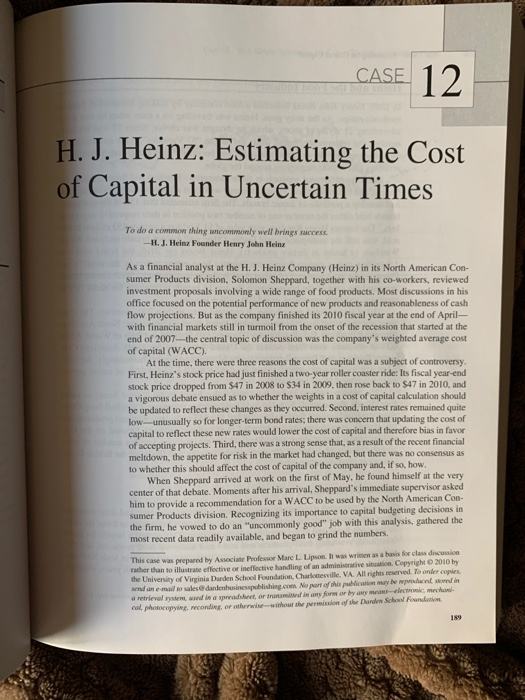
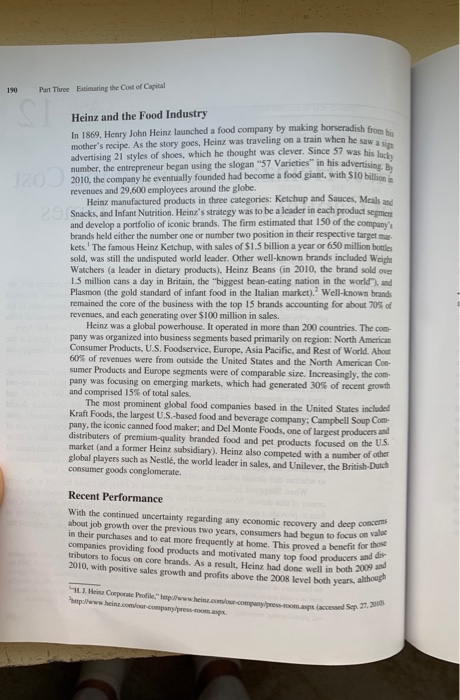

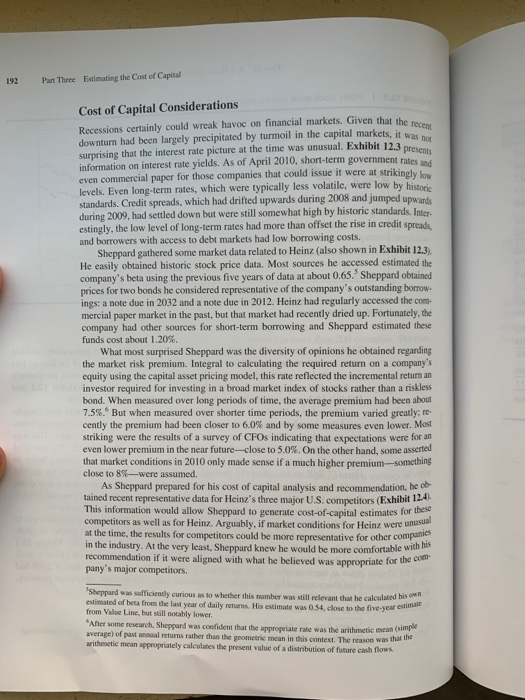
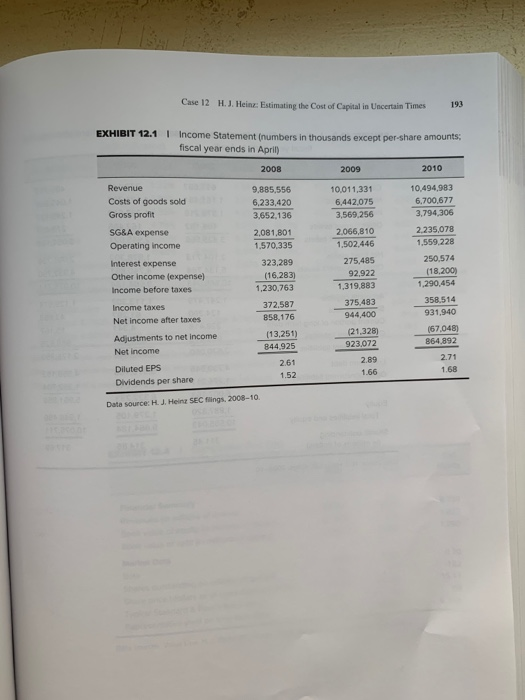
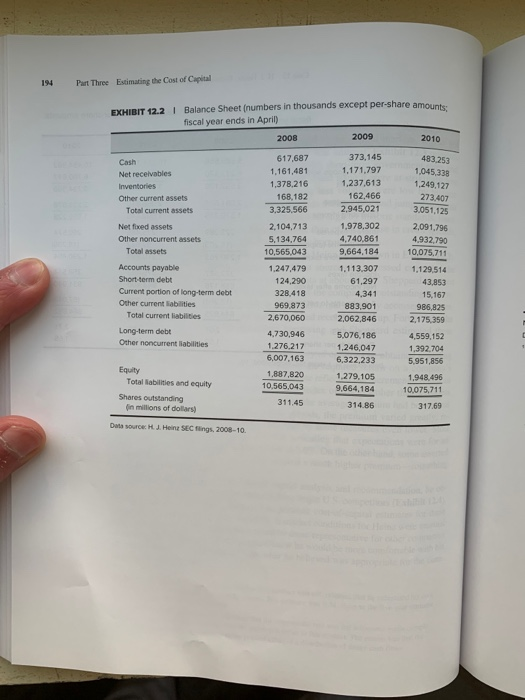
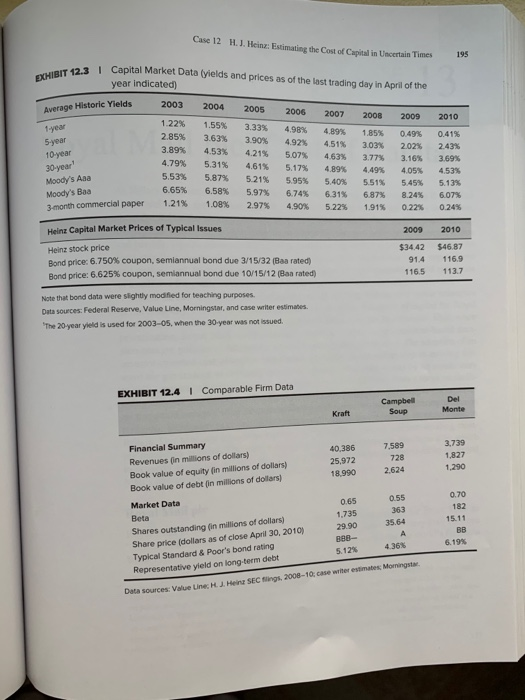
For the Heinz case please address the following questions:
- What were the yields on the two representative outstanding Heinz-debt issues as of the end of April 2010? What were they one year earlier?
- What was the WACC for Heinz at the start of the fiscal year 2010? What was the WACC one year earlier?
- What is your best estimate of the WACC for Kraft Foods, Campbell Soup Company, and Del Monte Foods? How do these WACCs influence your thinking about the WACC for Heinz?
Please answer these questions in Word format. I also need you to submit the Excel with your calculations. I will deduct for hardcoding where it was unnecessary!
CASE 12 H. J. Heinz: Estimating the Cost of Capital in Uncertain Times To do a common thing wicommonly well brings success. -H. J. Heinz Founder Henry John Heinz As a financial analyst at the H. J. Heinz Company (Heinz) in its North American Con sumer Products division, Solomon Sheppard, together with his co-workers, reviewed investment proposals involving a wide range of food products. Most discussions in his office focused on the potential performance of new products and reasonableness of cash flow projections. But as the company finished its 2010 fiscal year at the end of April- with financial markets still in turmoil from the onset of the recession that started at the end of 2007-the central topic of discussion was the company's weighted average cost of capital (WACC). At the time, there were three reasons the cost of capital was a subject of controversy First, Heinz's stock price had just finished a two-year roller coaster ride: Its fiscal year-end stock price dropped from $47 in 2008 to $34 in 2009, then rose back to S47 in 2010, and a vigorous debate ensued as to whether the weights in a cost of capital calculation should be updated to reflect these changes as they occurred. Second, interest rates remained quite lowunusually so for longer-term bond rates; there was concern that updating the cost of capital to reflect these new rates would lower the cost of capital and therefore bias in favor of accepting projects. Third, there was a strong sense that, as a result of the recent financial meltdown, the appetite for risk in the market had changed, but there was no consensus as to whether this should affect the cost of capital of the company and, if so, how. When Sheppard arrived at work on the first of May, he found himself at the very center of that debate. Moments after his arrival, Sheppard's immediate supervisor asked him to provide a recommendation for a WACC to be used by the North American Con- sumer Products division. Recognizing its importance to capital budgeting decisions in the firm, he vowed to do an "uncommonly good job with this analysis, gathered the most recent data readily available, and began to grind the numbers. This case was prepared by Associate Professor Mare L. Lipson. It was written as a basis for class discussion rather than to illustrate effective or ineffective handling of an administrative situation. Copyright 2010 by the University of Virginia Darden School Fundation, Charlesewville, VA. All rights reserved. To onder copies Soud an e-mail to sales@dandenbusiness publishing.com Neart of this publication may be an in a retrieval and in a spadeorra d in any form or by any mechan cal, photocopying, recording, or otherwise without the prison of the inden School Foundation 190 Part Three Estimating the Cost of Capital Heinz and the Food Industry In 1869, Henry John Heinz launched a food company by making horseradish from mother's recipe. As the story goes, Heinz was traveling on a train when he sawa advertising 21 styles of shoes, which he thought was clever. Since 57 was his lo number, the entrepreneur began using the slogan "57 Varieties in his advertisin 2010, the company he eventually founded had become a food giant, with S10 billi revenues and 29,600 employees around the globe. Heinz manufactured products in three categories: Ketchup and Sauces, Meals Snacks, and Infant Nutrition. Heinz's strategy was to be a leader in each product segmen and develop a portfolio of iconic brands. The firm estimated that 150 of the company's brands held either the number one or number two position in their respective target me kets. The famous Heinz Ketchup, with sales of $1.5 billion a year or 650 million bottles sold, was still the undisputed world leader. Other well-known brands included Weight Watchers (a leader in dietary products). Heinz Beans in 2010, the brand sold over 15 million cans a day in Britain, the biggest bean-eating nation in the world"), and Plasmon (the gold standard of infant food in the Italian market). Well-known brands remained the core of the business with the top 15 brands accounting for about 70% of revenues, and each generating over $100 million in sales. Heinz was a global powerhouse. It operated in more than 200 countries. The com- pany was organized into business segments based primarily on region: North American Consumer Products, U.S. Foodservice, Europe, Asia Pacific, and Rest of World. About 60% of revenues were from outside the United States and the North American Con- sumer Products and Europe segments were of comparable size. Increasingly, the com- pany was focusing on emerging markets, which had generated 30% of recent growth and comprised 15% of total sales. The most prominent global food companies based in the United States included Kraft Foods, the largest U.Sc-based food and beverage company: Campbell Soup Com pany, the iconic canned food maker; and Del Monte Foods, one of largest producers and distributers of premium quality branded food and pet products focused on the US market and a former Heinz subsidiary). Heinz also competed with a number of other global players such as Nestl, the world leader in sales, and Unilever, the British-Durch consumer goods conglomerate. Recent Performance With the continued uncertainty regarding any sconomic Recovery and deep Coo about job growth over the previous two years, consumers had been to focus on in their purchases and to eat more frequently at home. This proved a bencfit for companies providing food products and motivated many top food producers and tributors to focus on core brands. As a result Heinz had done well in boch 2009 2010, with positive sales growth and profits above the 2008 level both years, 11. Hea Corporate www.hm.com/ www .comercompany press room.aspx company pre-room map (accessed Sep 27, 2010 accessed Sep Case 12 H . Hein: Est do s Times 191 124 FIGURE 12.1 Heinz stock price and normalized S&P 500 Index. Normalized Index 10 5/2/2005 5/2/2006 5/2/2007 5/2/2008 5/2/2009 Dura sources: S&P 500 and Yahoo Finance 2010 profits were lower than those in 2009. These results were particularly striking since a surge in the price of corn syrup and an increase in the cost of packaging had necessitated price increases for most of its products. Overseas sales growth, particularly in Asia, had also positively affected the company's operations. Exhibit 12.1 and Exhibit 12.2 present financial results for the years 2008, 2009, and 2010. The relation between food company stock prices and the economy was compli- cated. In general, the performance of a food products company was not extremely sensi tive to market conditions and might even benefit from market uncertainty. This was clear to Heinz CFO Art Winkelblack, who in early 2009 had remarked, "I'm sure glad we're selling food and not washing machines or cars. People are coming home to Heinz Still an exceptionally prolonged struggle or another extreme market decline could drive more consumers to the private-label brands that represented a step down from the Heinz brands. While a double-dip recession seemed less likely in mid-2010, it was clear the economy continued to struggle, and this put pressure on margins. While the stock price for Heinz had been initially unaffected by adverse changes in the economy and did not decline with the market, starting in the third quarter of 2008 Heinz's stock price began tracking the market's movement quite closely. Figure 12.1 plots the Heinz stock price against the S&P Index (normalized to match Heinz's stock price at the start of the 2005 fiscal year). The low stock price at the start of 2009 had been characterized by some as an over-reaction and, even with the subsequent recovery, it was considered undervalued by some." Andrew Bary. "The Return of the Ketchup kid." Barron's January 26, 2009 "Bary: the same article noted that Heinz had above-average portfolio of brands led by its commanding global ketchup franchise" and, even at January 2009 prices, could be a tener target 192 Part Three Estimating the Cost of Capital Given that the recent Cost of Capital Considerations Recessions certainly could wreak havoc on financial markets. Given that the downturn had been largely precipitated by turmoil in the capital markets, it was surprising that the interest rate picture at the time was unusual. Exhibit 12.3 prese information on interest rate yields. As of April 2010, short-term government rates even commercial paper for those companies that could issue it were at strikingly lo levels. Even long-term rates, which were typically less volatile, were low by histori standards. Credit spreads, which had drifted upwards during 2008 and jumped upwards during 2009, had settled down but were still somewhat high by historic standards. Inter. estingly, the low level of long-term rates had more than offset the rise in credit spread and borrowers with access to debt markets had low borrowing costs. Sheppard gathered some market data related to Heinz (also shown in Exhibit 12.3) He easily obtained historic stock price data. Most sources he accessed estimated the company's beta using the previous five years of data at about 0.65. Sheppard obtained prices for two bonds he considered representative of the company's outstanding borrow. ings: a note due in 2032 and a note due in 2012. Heinz had regularly accessed the com- mercial paper market in the past, but that market had recently dried up. Fortunately, the company had other sources for short-term borrowing and Sheppard estimated these funds cost about 1.20%. What most surprised Sheppard was the diversity of opinions he obtained regarding the market risk premium. Integral to calculating the required return on a company's equity using the capital asset pricing model, this rate reflected the incremental return an investor required for investing in a broad market index of stocks rather than a riskless bond. When measured over long periods of time, the average premium had been about 7.5%. But when measured over shorter time periods, the premium varied greatly re- cently the premium had been closer to 6.0% and by some measures even lower. Most striking were the results of a survey of CFOs indicating that expectations were for an even lower premium in the near future-close to 5.0%. On the other hand, some asserted that market conditions in 2010 only made sense if a much higher premium--something close to 8%-were assumed. As Sheppard prepared for his cost of capital analysis and recommendation, he tained recent representative data for Heinz's three major U.S. competitors (Exhibit 1201 This information would allow Sheppard to generate cost of capital estimates for her competitors as well as for Heinz. Arguably, if market conditions for Heinz were unus at the time, the results for competitors could be more representative for other companic in the industry. At the very least, Sheppard knew he would be more comfortable win recommendation if it were aligned with what he believed was appropriate for the pany's major competitors. Sheppard was sufficiently curious as to whether this number was still relevant that he calculated his estimated of beta from the last year of daily returns. His estimate was 0.54, close to the five-year cand from Value Line, but still notably lower. Aner some research, Sheppard was confident that the appropriate rate was the arithmetic mean (simp average) of past anual returns rather than the geometric mean in this context. The reason was that the arithmetic mean appropriately calculates the present value of a distribution of future cash flows. Case 12 H.J. Heinz Estimating the Cost of Capital in Uncertain Times 193 EXHIBIT 12.1 Income Statement (numbers in thousands except per-share amounts fiscal year ends in April) 2008 2009 2010 Revenue 9.885,556 10,011,331 10,494,983 Costs of goods sold 6,233,420 6,442,075 6.700.677 Gross profit 3,652,136 3,569.256 3,794,306 SG&A expense 2,081,801 2,066,810 2.235,078 Operating income 1.570,335 1,502,446 1,559.228 Interest expense 323.289 275,485 250,574 Other income (expense) (16.283) 92,922 (18.200) Income before taxes 1,230,763 1,319,883 1,290.454 372,587 Income taxes 375,483 358.514 858,176 Net Income after taxes 944,400 931,940 (13.251) (21,328 (67,048) Adjustments to net income 844.925 923,072 864.892 Net Income 2.71 2.61 Diluted EPS 1.68 1.66 Dividends per share 2.89 1.52 Data source: H. J. Heinz SEC filings. 2008-10. 194 Part Three Estimating the Cost of Capital EXHIBIT 12.2 Balance Sheet (numbers in thousands except per share amount fiscal year ends in April) 2008 Cash Net receivables Inventories Other current assets Total current assets 617,687 1,161,481 1,378,216 168,182 3,325,566 2.104,713 5.134,764 10.565043 1.247,479 124,290 328.418 2010 4 83.253 1,045,338 1,249,127 273,407 3.051,125 2,091.796 4.932.790 10.075.711 Net fixed assets Other noncurrent assets Total assets Accounts payable Short-term debt Current portion of long-term debt Other current abilities Total current liabilities 2009 373.145 1,171.797 1.237,613 162.466 2.945,021 1,978,302 4,740.861 9,664,184 1.113.307 61,297 4.341 883.901 2,062,846 5,076,186 1,246,047 6.322,233 1,279.105 9,664,184 1,129.514 43.853 15.167 986,825 2.175.359 969 873 2670060 Long-term debt Other noncurrent liabilities 4,559,152 1.392,704 5.951,856 Equity Total abilities and equity Shares outstanding in millions of dollars) 4.730,946 1.276,217 6,007,163 1,887,820 10.565,043 311.45 1.948 496 10.075,711 314.86 317.69 Data source H. Heinz SEC filings, 2008-10 Case 12 HJ. Hein: Estimate the cost of insertain Times 195 EXHIBIT 12.3 200 Average Historic Yields 1 year 5 year 10 year 30 year' 3 Capital Market Data yields and prices as of the last trading day in April of the year indicated) Historic Yields 2003 2004 2005 2006 2007 2008 2009 1.22% 1.55% 3.33% 494 499% 185% 0.49% 2.85% 3.63% 3.90% 492 451% 3.03% 202% 3.89% 4.53% 4.21% 5.07% 4.63 377% 3.16% 4.79% 5.31% 4.61% 5.17% 4.89% 449% 4.05% 5.53% 5.87% 5.21% 5,95% 5.40% 551% 5.45% 6.65% 6.58% 5.97% 6.74% 6.31% 6.87% 8.24% a month commercial paper 1.21% 1.08% 2.97% 4,90% 5.22% 1.91% 0.22% 2009 Heinz Capital Market Prices of Typical Issues $34.42 Heinz Stock price 91.4 Bond price: 6.750% coupon, semiannual bond due 3/15/32 (Baa rated) 116.5 Bond price: 6.625% coupon, semiannual bond due 10/15/12 (Ban rated) 2010 0.41% 2.43% 3.69% 4.53% 5.13% 6.07% 0.24% Moody's Asa Moody's Baa 2010 $46.87 116.9 113.7 Note that bond data were slightly modified for teaching purposes. Data sources: Federal Reserve, Value Line, Morningstar, and case writer estimates The 20 year yield is used for 2003-05, when the 30 year was not issued. EXHIBIT 12.4 | Comparable Firm Data Campbell Soup Monte Kraft 3,739 1.827 40.386 25,972 18.990 1.290 Financial Summary Revenues (in millions of dollars) 7.589 Book value of equity (in millions of dollars) 728 Book value of debt (in millions of dollars) 2.624 Market Data 0.65 0.55 363 1.735 Shares outstanding in millions of dollars) 29.90 35.64 Share price (dollars as of close April 30, 2010) 888- Typical Standard & Poor's bond rating 5.12% 4.36% Representative yield on long-term debt Data sources Value Line H. Heinz SEC filings, 2008-10, case writer estimates Morning 0.70 182 15.11 Beta BB 6.19% CASE 12 H. J. Heinz: Estimating the Cost of Capital in Uncertain Times To do a common thing wicommonly well brings success. -H. J. Heinz Founder Henry John Heinz As a financial analyst at the H. J. Heinz Company (Heinz) in its North American Con sumer Products division, Solomon Sheppard, together with his co-workers, reviewed investment proposals involving a wide range of food products. Most discussions in his office focused on the potential performance of new products and reasonableness of cash flow projections. But as the company finished its 2010 fiscal year at the end of April- with financial markets still in turmoil from the onset of the recession that started at the end of 2007-the central topic of discussion was the company's weighted average cost of capital (WACC). At the time, there were three reasons the cost of capital was a subject of controversy First, Heinz's stock price had just finished a two-year roller coaster ride: Its fiscal year-end stock price dropped from $47 in 2008 to $34 in 2009, then rose back to S47 in 2010, and a vigorous debate ensued as to whether the weights in a cost of capital calculation should be updated to reflect these changes as they occurred. Second, interest rates remained quite lowunusually so for longer-term bond rates; there was concern that updating the cost of capital to reflect these new rates would lower the cost of capital and therefore bias in favor of accepting projects. Third, there was a strong sense that, as a result of the recent financial meltdown, the appetite for risk in the market had changed, but there was no consensus as to whether this should affect the cost of capital of the company and, if so, how. When Sheppard arrived at work on the first of May, he found himself at the very center of that debate. Moments after his arrival, Sheppard's immediate supervisor asked him to provide a recommendation for a WACC to be used by the North American Con- sumer Products division. Recognizing its importance to capital budgeting decisions in the firm, he vowed to do an "uncommonly good job with this analysis, gathered the most recent data readily available, and began to grind the numbers. This case was prepared by Associate Professor Mare L. Lipson. It was written as a basis for class discussion rather than to illustrate effective or ineffective handling of an administrative situation. Copyright 2010 by the University of Virginia Darden School Fundation, Charlesewville, VA. All rights reserved. To onder copies Soud an e-mail to sales@dandenbusiness publishing.com Neart of this publication may be an in a retrieval and in a spadeorra d in any form or by any mechan cal, photocopying, recording, or otherwise without the prison of the inden School Foundation 190 Part Three Estimating the Cost of Capital Heinz and the Food Industry In 1869, Henry John Heinz launched a food company by making horseradish from mother's recipe. As the story goes, Heinz was traveling on a train when he sawa advertising 21 styles of shoes, which he thought was clever. Since 57 was his lo number, the entrepreneur began using the slogan "57 Varieties in his advertisin 2010, the company he eventually founded had become a food giant, with S10 billi revenues and 29,600 employees around the globe. Heinz manufactured products in three categories: Ketchup and Sauces, Meals Snacks, and Infant Nutrition. Heinz's strategy was to be a leader in each product segmen and develop a portfolio of iconic brands. The firm estimated that 150 of the company's brands held either the number one or number two position in their respective target me kets. The famous Heinz Ketchup, with sales of $1.5 billion a year or 650 million bottles sold, was still the undisputed world leader. Other well-known brands included Weight Watchers (a leader in dietary products). Heinz Beans in 2010, the brand sold over 15 million cans a day in Britain, the biggest bean-eating nation in the world"), and Plasmon (the gold standard of infant food in the Italian market). Well-known brands remained the core of the business with the top 15 brands accounting for about 70% of revenues, and each generating over $100 million in sales. Heinz was a global powerhouse. It operated in more than 200 countries. The com- pany was organized into business segments based primarily on region: North American Consumer Products, U.S. Foodservice, Europe, Asia Pacific, and Rest of World. About 60% of revenues were from outside the United States and the North American Con- sumer Products and Europe segments were of comparable size. Increasingly, the com- pany was focusing on emerging markets, which had generated 30% of recent growth and comprised 15% of total sales. The most prominent global food companies based in the United States included Kraft Foods, the largest U.Sc-based food and beverage company: Campbell Soup Com pany, the iconic canned food maker; and Del Monte Foods, one of largest producers and distributers of premium quality branded food and pet products focused on the US market and a former Heinz subsidiary). Heinz also competed with a number of other global players such as Nestl, the world leader in sales, and Unilever, the British-Durch consumer goods conglomerate. Recent Performance With the continued uncertainty regarding any sconomic Recovery and deep Coo about job growth over the previous two years, consumers had been to focus on in their purchases and to eat more frequently at home. This proved a bencfit for companies providing food products and motivated many top food producers and tributors to focus on core brands. As a result Heinz had done well in boch 2009 2010, with positive sales growth and profits above the 2008 level both years, 11. Hea Corporate www.hm.com/ www .comercompany press room.aspx company pre-room map (accessed Sep 27, 2010 accessed Sep Case 12 H . Hein: Est do s Times 191 124 FIGURE 12.1 Heinz stock price and normalized S&P 500 Index. Normalized Index 10 5/2/2005 5/2/2006 5/2/2007 5/2/2008 5/2/2009 Dura sources: S&P 500 and Yahoo Finance 2010 profits were lower than those in 2009. These results were particularly striking since a surge in the price of corn syrup and an increase in the cost of packaging had necessitated price increases for most of its products. Overseas sales growth, particularly in Asia, had also positively affected the company's operations. Exhibit 12.1 and Exhibit 12.2 present financial results for the years 2008, 2009, and 2010. The relation between food company stock prices and the economy was compli- cated. In general, the performance of a food products company was not extremely sensi tive to market conditions and might even benefit from market uncertainty. This was clear to Heinz CFO Art Winkelblack, who in early 2009 had remarked, "I'm sure glad we're selling food and not washing machines or cars. People are coming home to Heinz Still an exceptionally prolonged struggle or another extreme market decline could drive more consumers to the private-label brands that represented a step down from the Heinz brands. While a double-dip recession seemed less likely in mid-2010, it was clear the economy continued to struggle, and this put pressure on margins. While the stock price for Heinz had been initially unaffected by adverse changes in the economy and did not decline with the market, starting in the third quarter of 2008 Heinz's stock price began tracking the market's movement quite closely. Figure 12.1 plots the Heinz stock price against the S&P Index (normalized to match Heinz's stock price at the start of the 2005 fiscal year). The low stock price at the start of 2009 had been characterized by some as an over-reaction and, even with the subsequent recovery, it was considered undervalued by some." Andrew Bary. "The Return of the Ketchup kid." Barron's January 26, 2009 "Bary: the same article noted that Heinz had above-average portfolio of brands led by its commanding global ketchup franchise" and, even at January 2009 prices, could be a tener target 192 Part Three Estimating the Cost of Capital Given that the recent Cost of Capital Considerations Recessions certainly could wreak havoc on financial markets. Given that the downturn had been largely precipitated by turmoil in the capital markets, it was surprising that the interest rate picture at the time was unusual. Exhibit 12.3 prese information on interest rate yields. As of April 2010, short-term government rates even commercial paper for those companies that could issue it were at strikingly lo levels. Even long-term rates, which were typically less volatile, were low by histori standards. Credit spreads, which had drifted upwards during 2008 and jumped upwards during 2009, had settled down but were still somewhat high by historic standards. Inter. estingly, the low level of long-term rates had more than offset the rise in credit spread and borrowers with access to debt markets had low borrowing costs. Sheppard gathered some market data related to Heinz (also shown in Exhibit 12.3) He easily obtained historic stock price data. Most sources he accessed estimated the company's beta using the previous five years of data at about 0.65. Sheppard obtained prices for two bonds he considered representative of the company's outstanding borrow. ings: a note due in 2032 and a note due in 2012. Heinz had regularly accessed the com- mercial paper market in the past, but that market had recently dried up. Fortunately, the company had other sources for short-term borrowing and Sheppard estimated these funds cost about 1.20%. What most surprised Sheppard was the diversity of opinions he obtained regarding the market risk premium. Integral to calculating the required return on a company's equity using the capital asset pricing model, this rate reflected the incremental return an investor required for investing in a broad market index of stocks rather than a riskless bond. When measured over long periods of time, the average premium had been about 7.5%. But when measured over shorter time periods, the premium varied greatly re- cently the premium had been closer to 6.0% and by some measures even lower. Most striking were the results of a survey of CFOs indicating that expectations were for an even lower premium in the near future-close to 5.0%. On the other hand, some asserted that market conditions in 2010 only made sense if a much higher premium--something close to 8%-were assumed. As Sheppard prepared for his cost of capital analysis and recommendation, he tained recent representative data for Heinz's three major U.S. competitors (Exhibit 1201 This information would allow Sheppard to generate cost of capital estimates for her competitors as well as for Heinz. Arguably, if market conditions for Heinz were unus at the time, the results for competitors could be more representative for other companic in the industry. At the very least, Sheppard knew he would be more comfortable win recommendation if it were aligned with what he believed was appropriate for the pany's major competitors. Sheppard was sufficiently curious as to whether this number was still relevant that he calculated his estimated of beta from the last year of daily returns. His estimate was 0.54, close to the five-year cand from Value Line, but still notably lower. Aner some research, Sheppard was confident that the appropriate rate was the arithmetic mean (simp average) of past anual returns rather than the geometric mean in this context. The reason was that the arithmetic mean appropriately calculates the present value of a distribution of future cash flows. Case 12 H.J. Heinz Estimating the Cost of Capital in Uncertain Times 193 EXHIBIT 12.1 Income Statement (numbers in thousands except per-share amounts fiscal year ends in April) 2008 2009 2010 Revenue 9.885,556 10,011,331 10,494,983 Costs of goods sold 6,233,420 6,442,075 6.700.677 Gross profit 3,652,136 3,569.256 3,794,306 SG&A expense 2,081,801 2,066,810 2.235,078 Operating income 1.570,335 1,502,446 1,559.228 Interest expense 323.289 275,485 250,574 Other income (expense) (16.283) 92,922 (18.200) Income before taxes 1,230,763 1,319,883 1,290.454 372,587 Income taxes 375,483 358.514 858,176 Net Income after taxes 944,400 931,940 (13.251) (21,328 (67,048) Adjustments to net income 844.925 923,072 864.892 Net Income 2.71 2.61 Diluted EPS 1.68 1.66 Dividends per share 2.89 1.52 Data source: H. J. Heinz SEC filings. 2008-10. 194 Part Three Estimating the Cost of Capital EXHIBIT 12.2 Balance Sheet (numbers in thousands except per share amount fiscal year ends in April) 2008 Cash Net receivables Inventories Other current assets Total current assets 617,687 1,161,481 1,378,216 168,182 3,325,566 2.104,713 5.134,764 10.565043 1.247,479 124,290 328.418 2010 4 83.253 1,045,338 1,249,127 273,407 3.051,125 2,091.796 4.932.790 10.075.711 Net fixed assets Other noncurrent assets Total assets Accounts payable Short-term debt Current portion of long-term debt Other current abilities Total current liabilities 2009 373.145 1,171.797 1.237,613 162.466 2.945,021 1,978,302 4,740.861 9,664,184 1.113.307 61,297 4.341 883.901 2,062,846 5,076,186 1,246,047 6.322,233 1,279.105 9,664,184 1,129.514 43.853 15.167 986,825 2.175.359 969 873 2670060 Long-term debt Other noncurrent liabilities 4,559,152 1.392,704 5.951,856 Equity Total abilities and equity Shares outstanding in millions of dollars) 4.730,946 1.276,217 6,007,163 1,887,820 10.565,043 311.45 1.948 496 10.075,711 314.86 317.69 Data source H. Heinz SEC filings, 2008-10 Case 12 HJ. Hein: Estimate the cost of insertain Times 195 EXHIBIT 12.3 200 Average Historic Yields 1 year 5 year 10 year 30 year' 3 Capital Market Data yields and prices as of the last trading day in April of the year indicated) Historic Yields 2003 2004 2005 2006 2007 2008 2009 1.22% 1.55% 3.33% 494 499% 185% 0.49% 2.85% 3.63% 3.90% 492 451% 3.03% 202% 3.89% 4.53% 4.21% 5.07% 4.63 377% 3.16% 4.79% 5.31% 4.61% 5.17% 4.89% 449% 4.05% 5.53% 5.87% 5.21% 5,95% 5.40% 551% 5.45% 6.65% 6.58% 5.97% 6.74% 6.31% 6.87% 8.24% a month commercial paper 1.21% 1.08% 2.97% 4,90% 5.22% 1.91% 0.22% 2009 Heinz Capital Market Prices of Typical Issues $34.42 Heinz Stock price 91.4 Bond price: 6.750% coupon, semiannual bond due 3/15/32 (Baa rated) 116.5 Bond price: 6.625% coupon, semiannual bond due 10/15/12 (Ban rated) 2010 0.41% 2.43% 3.69% 4.53% 5.13% 6.07% 0.24% Moody's Asa Moody's Baa 2010 $46.87 116.9 113.7 Note that bond data were slightly modified for teaching purposes. Data sources: Federal Reserve, Value Line, Morningstar, and case writer estimates The 20 year yield is used for 2003-05, when the 30 year was not issued. EXHIBIT 12.4 | Comparable Firm Data Campbell Soup Monte Kraft 3,739 1.827 40.386 25,972 18.990 1.290 Financial Summary Revenues (in millions of dollars) 7.589 Book value of equity (in millions of dollars) 728 Book value of debt (in millions of dollars) 2.624 Market Data 0.65 0.55 363 1.735 Shares outstanding in millions of dollars) 29.90 35.64 Share price (dollars as of close April 30, 2010) 888- Typical Standard & Poor's bond rating 5.12% 4.36% Representative yield on long-term debt Data sources Value Line H. Heinz SEC filings, 2008-10, case writer estimates Morning 0.70 182 15.11 Beta BB 6.19%Step by Step Solution
There are 3 Steps involved in it
Step: 1

Get Instant Access to Expert-Tailored Solutions
See step-by-step solutions with expert insights and AI powered tools for academic success
Step: 2

Step: 3

Ace Your Homework with AI
Get the answers you need in no time with our AI-driven, step-by-step assistance
Get Started


